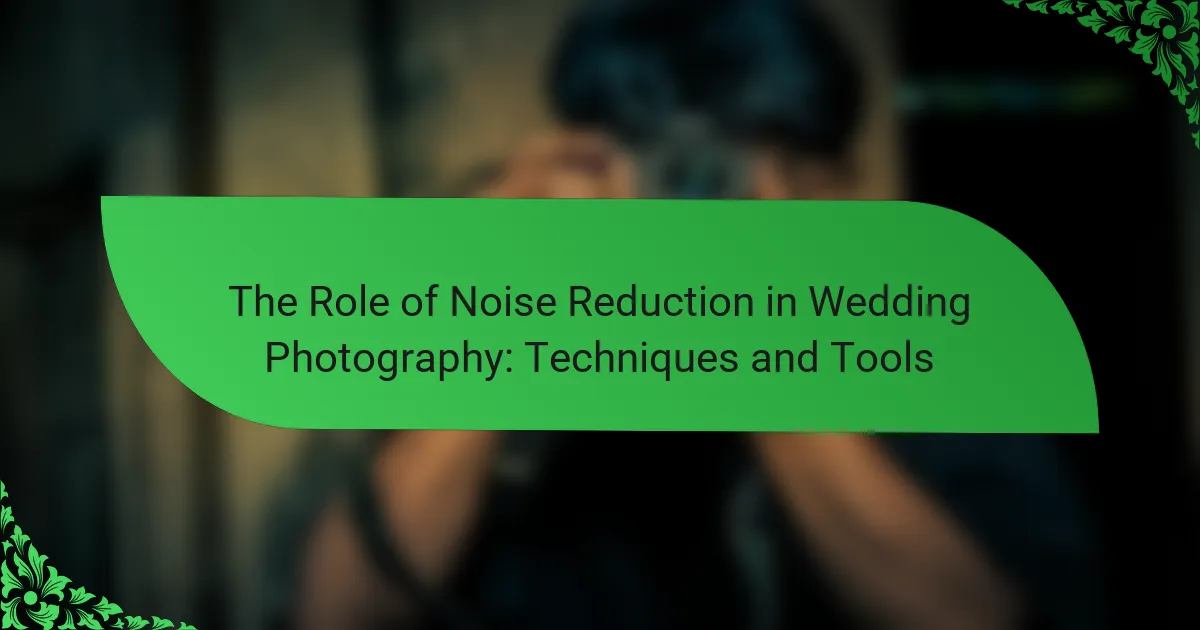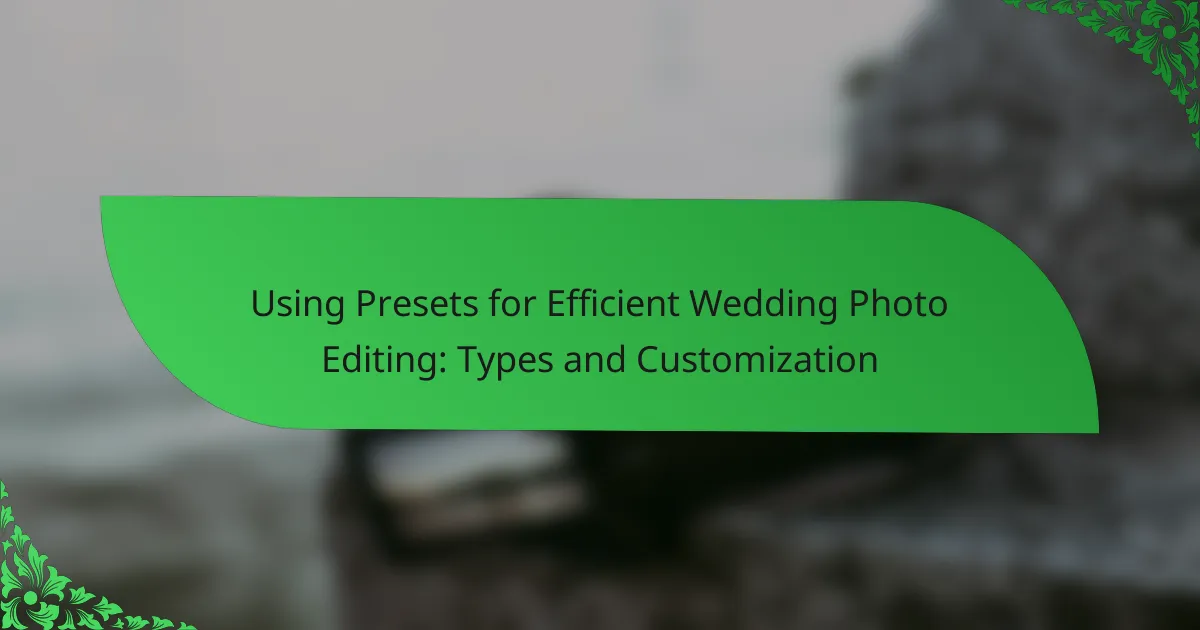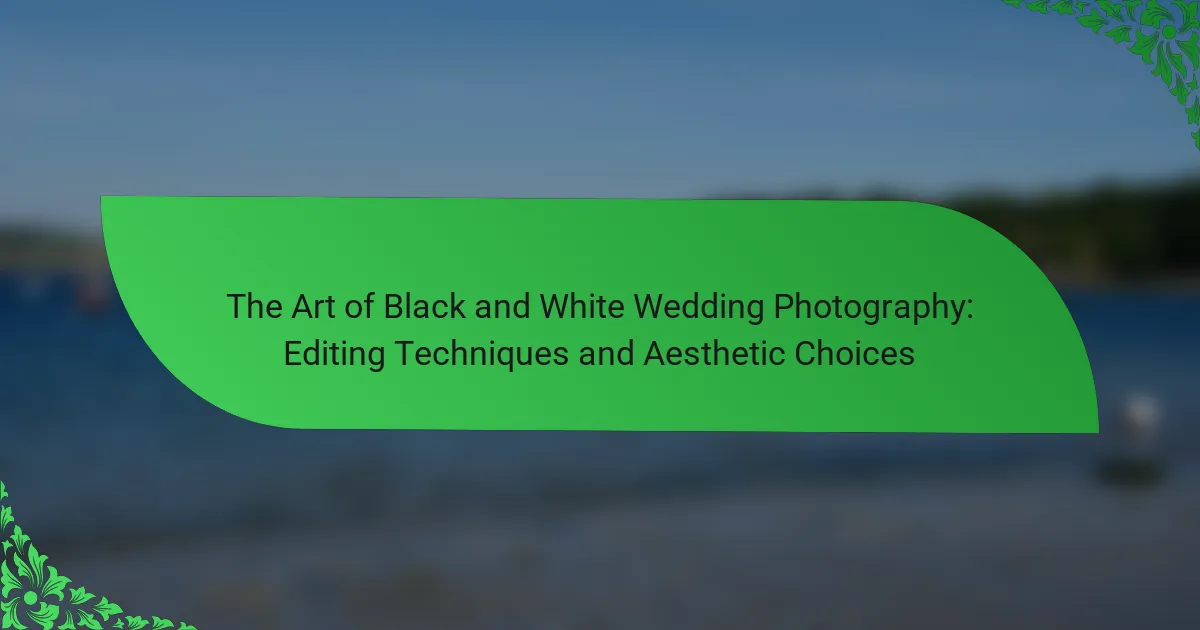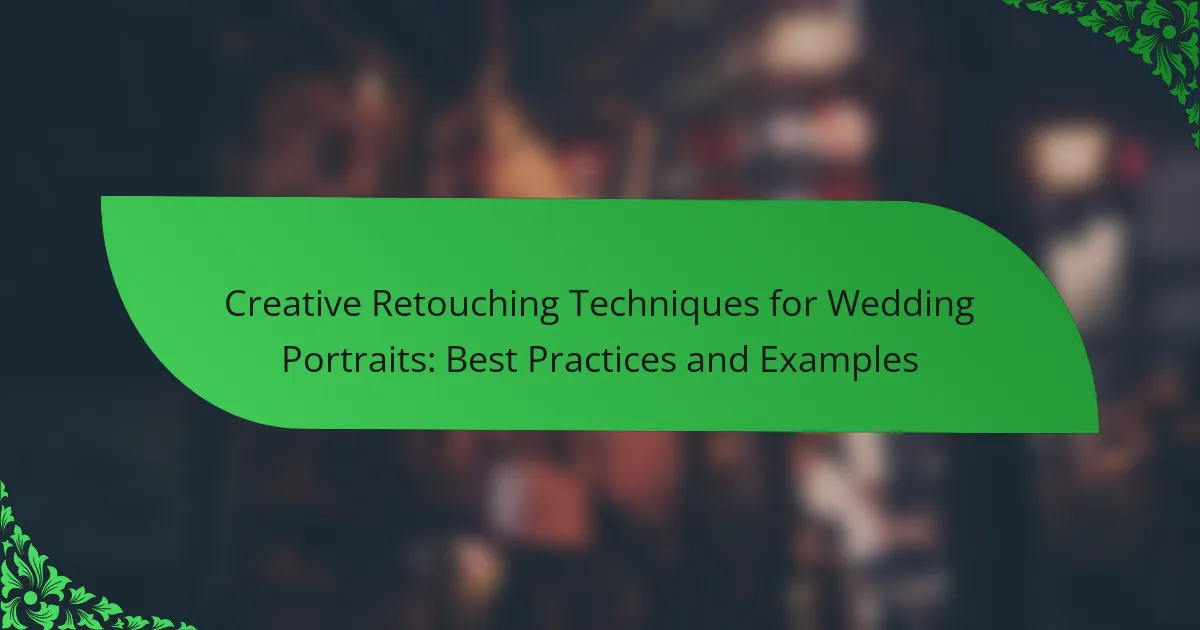Noise reduction is a critical component in wedding photography that enhances image clarity and minimizes unwanted grain, particularly in low-light settings typical of weddings. The article explores various techniques and tools used for effective noise reduction, including software like Adobe Lightroom and Photoshop, as well as camera settings adjustments and proper lighting methods. It details the impact of noise reduction on the aesthetic quality of photographs, including smoother skin tones and clearer details, which are vital for capturing memorable moments. Additionally, it highlights specific noise reduction plugins and in-camera settings that can further improve image quality, emphasizing the importance of these methods in delivering appealing final outputs to clients.
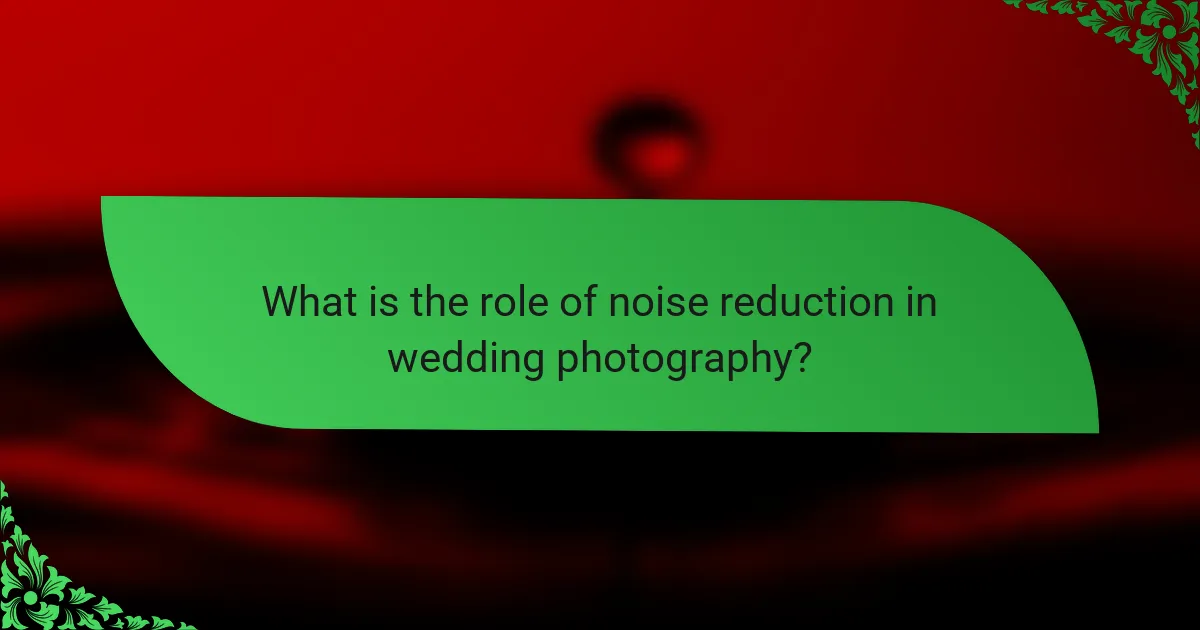
What is the role of noise reduction in wedding photography?
Noise reduction in wedding photography minimizes unwanted grain and enhances image clarity. It plays a crucial role in producing high-quality photographs, especially in low-light settings typical of weddings. Effective noise reduction techniques improve the overall aesthetic of images. This results in smoother skin tones and clearer details, which are essential for capturing memorable moments. Additionally, noise reduction can help maintain the integrity of colors and contrasts in photographs. Various tools and software are available for photographers to effectively reduce noise. These methods can significantly elevate the final output, making the images more appealing to clients.
How does noise affect wedding photographs?
Noise negatively impacts wedding photographs by introducing graininess and reducing image clarity. This distraction can detract from the emotional quality of the images. High noise levels often occur in low-light conditions, which are common during weddings. As a result, important details may become obscured. Photographers typically strive for clean images to capture moments accurately. The presence of noise can also affect color accuracy, leading to unnatural hues. Techniques such as noise reduction software can help mitigate these effects. Effective noise management enhances the overall quality of wedding photography.
What types of noise are commonly found in wedding photography?
Common types of noise found in wedding photography include luminance noise and chromatic noise. Luminance noise appears as grainy textures in images, particularly in low-light conditions. Chromatic noise manifests as color distortions or speckles, often visible in shadows. Both types of noise can detract from image quality. They are more prevalent in high ISO settings or when using slower shutter speeds. Understanding these noise types helps photographers apply effective noise reduction techniques.
How does noise impact the overall quality of wedding images?
Noise negatively impacts the overall quality of wedding images by introducing graininess and reducing clarity. High noise levels can obscure details and diminish the visual appeal of photos. This is particularly detrimental in low-light settings, common during wedding receptions. Images with excessive noise may appear unprofessional and less memorable. Studies show that noise can lower viewer satisfaction and emotional response to images. Therefore, effective noise reduction techniques are crucial for enhancing image quality. Reducing noise leads to sharper, more vibrant wedding photos that capture the essence of the event.
Why is noise reduction important for wedding photographers?
Noise reduction is important for wedding photographers because it enhances image quality. High noise levels can obscure details in low-light settings, common at weddings. Clear images are essential for preserving memories and ensuring client satisfaction. Effective noise reduction techniques improve the overall aesthetic of photographs. Studies show that images with reduced noise are perceived as more professional. This is particularly crucial in capturing moments like speeches and dances. Wedding photographers often work in challenging lighting conditions, making noise reduction vital. Ultimately, it helps deliver high-quality images that clients cherish.
What benefits does effective noise reduction provide in wedding photography?
Effective noise reduction enhances image quality in wedding photography. It reduces graininess and improves clarity in low-light conditions. Clearer images capture details and emotions more effectively. This leads to higher satisfaction for couples receiving their photos. Noise reduction also allows for better color accuracy and skin tone representation. Improved image quality can enhance the photographer’s portfolio. This, in turn, can attract more clients seeking high-quality wedding photography. Overall, effective noise reduction contributes significantly to the artistry and professionalism of wedding photography.
How does noise reduction enhance the emotional impact of wedding photos?
Noise reduction enhances the emotional impact of wedding photos by improving image clarity and focus. Clearer images allow viewers to connect more deeply with the emotions captured. Reduced noise minimizes distractions, making the subjects’ expressions and moments more prominent. This focus on detail helps convey the atmosphere of the event. High-quality images evoke stronger emotional responses from viewers. Studies show that visually appealing photos lead to greater engagement and emotional resonance. Therefore, effective noise reduction techniques contribute significantly to the overall emotional storytelling in wedding photography.
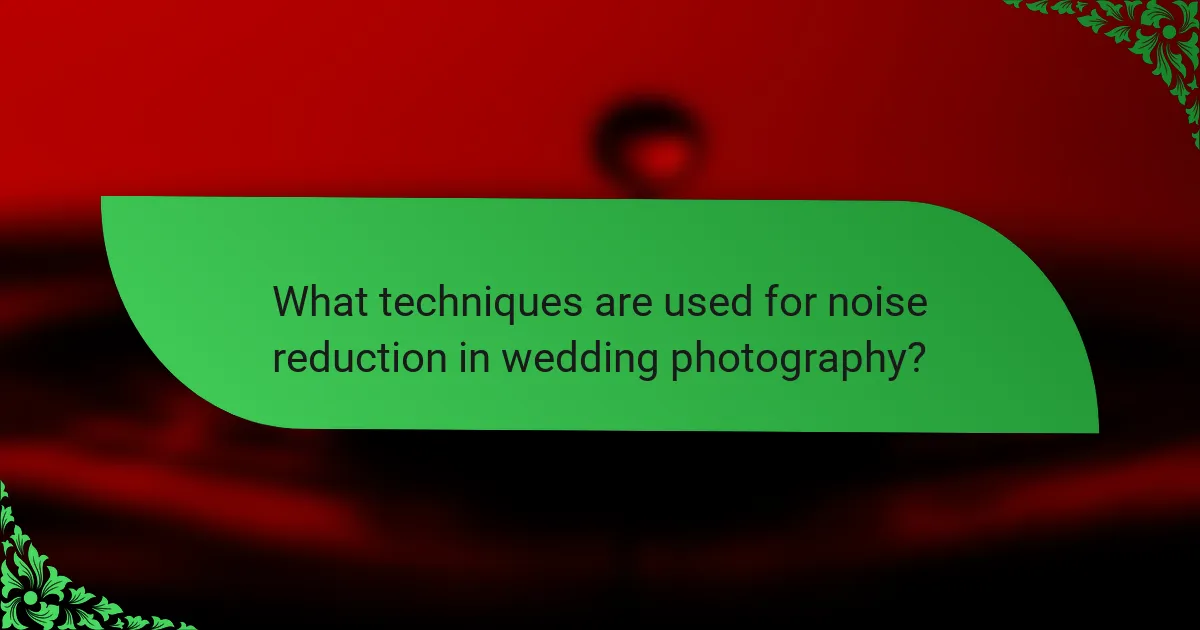
What techniques are used for noise reduction in wedding photography?
Common techniques for noise reduction in wedding photography include using noise reduction software, adjusting camera settings, and employing proper lighting. Noise reduction software, such as Adobe Lightroom or Photoshop, applies algorithms to minimize graininess. Adjusting camera settings, like lowering ISO, reduces sensor noise in low-light conditions. Proper lighting techniques, including using external flashes or reflectors, enhance image quality and decrease noise. Photographers often combine these methods for optimal results. Studies show that effective noise reduction improves image clarity and overall aesthetic.
How can photographers utilize camera settings for noise reduction?
Photographers can utilize camera settings for noise reduction by adjusting ISO, shutter speed, and aperture. Lowering the ISO setting reduces the camera’s sensitivity to light, which minimizes noise. A lower ISO value, such as 100 or 200, produces cleaner images. Increasing shutter speed helps reduce motion blur and can also lessen noise in well-lit conditions. Using a wider aperture allows more light to enter the camera, enabling lower ISO settings. Additionally, enabling in-camera noise reduction features can further improve image quality. Many cameras offer long exposure noise reduction options that work effectively during extended shoots. These settings collectively enhance image clarity, especially in low-light environments.
What ISO settings are optimal for reducing noise in low-light conditions?
ISO settings between 100 and 800 are optimal for reducing noise in low-light conditions. Lower ISO values produce less noise but require more light. Higher ISO values increase sensitivity but can introduce graininess. For wedding photography, ISO 400 is often a balanced choice. It provides adequate sensitivity while maintaining image quality. In practice, using a tripod can allow for lower ISO settings. This further minimizes noise while capturing clear images in low-light environments.
How does exposure time influence noise levels in wedding photos?
Exposure time directly influences noise levels in wedding photos. Longer exposure times can lead to increased noise, particularly in low-light conditions. This occurs because the camera sensor accumulates more light, which also amplifies electronic noise. Shorter exposure times typically result in less noise, as there is less time for noise to build up. However, shorter exposures may require higher ISO settings, which can also introduce noise. Therefore, photographers must balance exposure time with ISO settings to achieve optimal image quality. Studies show that reducing exposure time to a minimum necessary level can significantly decrease noise levels in images.
What post-processing techniques are effective for noise reduction?
Effective post-processing techniques for noise reduction include noise reduction filters, frequency separation, and selective editing. Noise reduction filters, such as those in Adobe Lightroom and Photoshop, reduce grainy textures while preserving detail. Frequency separation allows photographers to separate high-frequency details from low-frequency noise, making it easier to manage noise. Selective editing targets specific areas of an image, applying noise reduction only where needed. These methods help enhance image quality while maintaining the overall aesthetic. Studies show that using these techniques can significantly improve the clarity and professionalism of wedding photographs.
Which software tools are best for reducing noise in wedding images?
Adobe Lightroom is one of the best software tools for reducing noise in wedding images. It offers advanced noise reduction features that work effectively on high ISO images. Capture One is another excellent option, providing powerful noise reduction capabilities with customizable settings. DxO PhotoLab is also highly regarded for its noise reduction technology, particularly in low-light conditions. Topaz DeNoise AI uses artificial intelligence to reduce noise while preserving detail, making it ideal for wedding photography. Each of these tools has been widely used by professional photographers to enhance image quality.
How can photographers balance noise reduction with image sharpness?
Photographers can balance noise reduction with image sharpness by using selective noise reduction techniques. This approach allows them to apply noise reduction only to areas of the image that require it, such as shadows or uniform backgrounds. They can maintain sharpness in critical areas like subjects or details.
Using software tools like Adobe Lightroom or Photoshop, photographers can adjust noise reduction sliders while previewing the image. This enables them to find the optimal balance between reducing noise and preserving detail.
Additionally, shooting at lower ISO settings can help reduce noise from the outset. A lower ISO often results in clearer, sharper images.
Overall, careful application of noise reduction combined with attention to ISO settings can help photographers achieve high-quality images.
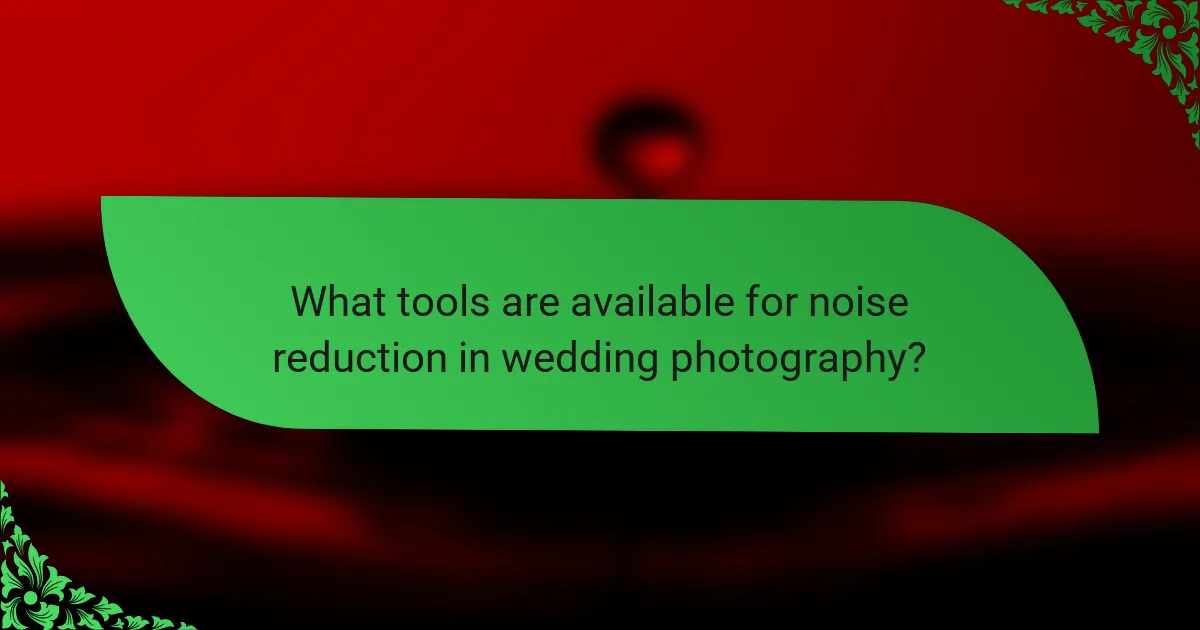
What tools are available for noise reduction in wedding photography?
Noise reduction tools in wedding photography include software and plugins. Popular software options are Adobe Lightroom and Photoshop. These programs provide noise reduction filters that can be adjusted for various levels of noise. Capture One is another software favored by professionals for its advanced noise reduction capabilities.
Plugins like Neat Image and Topaz DeNoise are specifically designed for noise reduction. They offer enhanced algorithms for better results. Additionally, some camera manufacturers provide in-camera noise reduction settings. These settings can minimize noise during image capture, especially in low-light conditions.
Using these tools can significantly improve image quality in wedding photography. Studies show that effective noise reduction enhances the overall aesthetic of photographs.
What are the most popular noise reduction software options?
The most popular noise reduction software options include Adobe Lightroom, Topaz DeNoise AI, and Neat Image. Adobe Lightroom is widely used for its comprehensive editing tools and effective noise reduction features. Topaz DeNoise AI utilizes artificial intelligence to enhance image quality while reducing noise. Neat Image is known for its advanced noise reduction algorithms and is favored by many photographers for its precision. These tools are essential for wedding photography, where maintaining image quality is crucial.
How do different software tools compare in terms of effectiveness?
Different software tools for noise reduction in wedding photography vary in effectiveness. Tools like Adobe Lightroom and Topaz DeNoise AI offer advanced algorithms for superior noise reduction. Lightroom provides a user-friendly interface and integrates well with other Adobe products. Topaz DeNoise AI uses artificial intelligence to analyze images and reduce noise while preserving detail.
Research shows that Topaz DeNoise AI can achieve a noise reduction rate of up to 80% without compromising image quality. In contrast, older software tools may struggle with preserving fine details during noise reduction. User reviews indicate that Lightroom is preferred for batch processing, while Topaz is favored for individual image enhancement.
Ultimately, the choice of software depends on specific needs, such as ease of use and desired output quality.
What features should photographers look for in noise reduction tools?
Photographers should look for several key features in noise reduction tools. Effective noise reduction tools should offer adjustable noise reduction levels. This allows photographers to customize the effect based on their specific needs. Another important feature is the ability to preserve detail while reducing noise. Tools that maintain image sharpness are essential for high-quality results.
Additionally, photographers should consider tools with batch processing capabilities. This feature saves time when editing multiple images. A user-friendly interface is also crucial for efficient workflow. Photographers benefit from software that is easy to navigate.
Finally, compatibility with various file formats is important. Many photographers work with RAW files, so tools should support these formats. Overall, these features enhance the effectiveness of noise reduction tools in wedding photography.
What hardware can assist in noise reduction during wedding shoots?
Microphones with noise-canceling technology can assist in noise reduction during wedding shoots. These microphones filter out background noise, capturing clearer audio. Lavalier microphones are discreet and effective for capturing speech. Shotgun microphones focus on sound from a specific direction, minimizing ambient noise. Additionally, using windshields on microphones reduces wind noise during outdoor shoots. Audio recorders with built-in noise reduction features enhance sound quality. High-quality headphones allow for better monitoring of audio during recording. These hardware options significantly improve the overall audio clarity in wedding videos.
How do camera models influence noise performance?
Camera models significantly influence noise performance due to variations in sensor technology and design. Different models utilize distinct sensor sizes, such as full-frame or APS-C, which affect light capture efficiency. Larger sensors generally produce less noise at high ISO settings compared to smaller sensors. Additionally, camera models differ in their noise reduction algorithms and processing capabilities. High-end models often feature advanced noise reduction technology that minimizes noise during image processing. This results in cleaner images, especially in low-light conditions. For instance, the Canon EOS R5 shows superior noise performance at ISO 3200 compared to entry-level models. Therefore, the choice of camera model directly impacts the noise levels in images captured during wedding photography.
What role do lenses play in minimizing noise in wedding photography?
Lenses play a significant role in minimizing noise in wedding photography by controlling light intake. High-quality lenses with larger apertures allow more light to enter the camera. This increased light helps reduce the need for higher ISO settings. Lower ISO settings result in less digital noise in images. Additionally, lenses with advanced optical designs can enhance image clarity. This enhancement further contributes to noise reduction by improving overall image quality. Research indicates that using prime lenses can yield sharper images with less noise compared to zoom lenses. Therefore, the choice of lens directly impacts noise levels in wedding photography.
What are some best practices for effective noise reduction in wedding photography?
Use a low ISO setting to minimize noise in wedding photography. A lower ISO reduces the camera sensor’s sensitivity to light, which decreases graininess. When shooting in low light, consider using a tripod to stabilize the camera. This allows for longer exposure times without increasing the ISO. Utilize noise reduction software during post-processing to enhance image quality. Programs like Adobe Lightroom and Photoshop have effective noise reduction tools. Shoot in RAW format to retain more detail for better noise reduction options. Adjust exposure settings carefully to balance light and avoid overexposure, which can amplify noise. Lastly, consider using fast lenses with wider apertures to capture more light. This also helps maintain lower ISO settings.
How can photographers prepare for low-light conditions to reduce noise?
Photographers can prepare for low-light conditions to reduce noise by using a lower ISO setting. A lower ISO reduces the sensor’s sensitivity to light, which minimizes noise. Photographers should also use a tripod to stabilize the camera. This allows for longer exposure times without camera shake. Additionally, using a lens with a wider aperture lets in more light. A wider aperture can help capture images at lower ISO settings. Photographers can also shoot in RAW format. RAW files retain more detail and allow for better noise reduction in post-processing. Lastly, using noise reduction software during editing can further decrease noise in images.
What tips can help photographers achieve the best results with noise reduction tools?
Photographers can achieve the best results with noise reduction tools by following specific techniques. First, they should shoot in RAW format. This format retains more data, allowing for better noise reduction during post-processing. Second, adjusting the camera settings can help. Lowering the ISO reduces noise at the source. Third, applying noise reduction in moderation is crucial. Overusing the tool can lead to loss of detail. Fourth, utilizing selective noise reduction can enhance image quality. This technique targets specific areas rather than applying it globally. Lastly, experimenting with different software options is beneficial. Each software offers unique algorithms that may yield better results for specific images.
The main entity of this article is noise reduction in wedding photography. The article explores the importance of noise reduction techniques in enhancing image quality, particularly in low-light settings typical of weddings. It discusses the negative impact of noise on image clarity and emotional resonance, outlines common types of noise, and highlights effective noise reduction methods and tools, including software options like Adobe Lightroom and Topaz DeNoise AI. Additionally, it provides practical tips for photographers on camera settings, post-processing techniques, and best practices to achieve optimal results in wedding photography.
